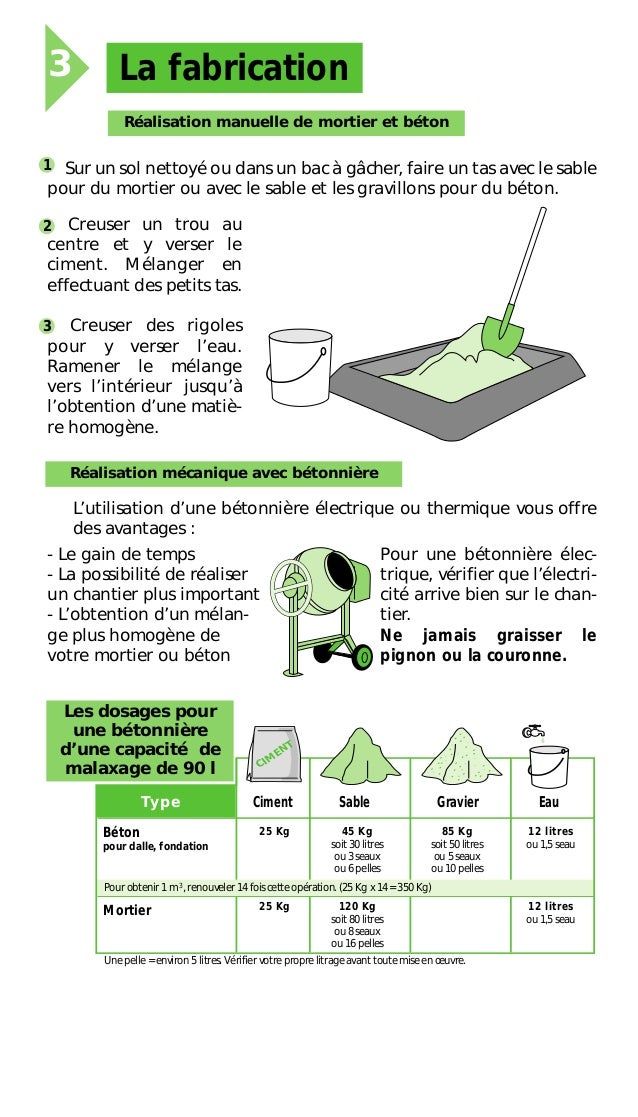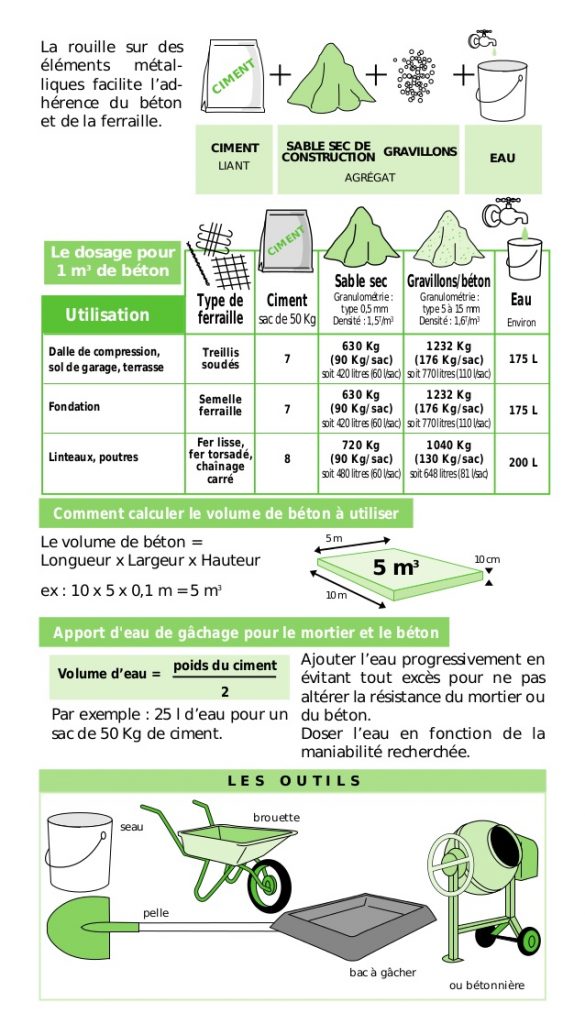Concrete Mixing Dosage: The Ultimate Guide To Perfect Your Pile Of Concrete
Ever wondered how much cement, sand, and gravel you need for that perfect concrete mix? Well, buckle up because we're diving deep into the world of concrete mixing dosage. Today, we’ll uncover the secrets behind getting the perfect "dosage pour beton en pelle" that’ll make your DIY projects a success.
Concrete is more than just a mix of materials—it’s an art form. Whether you're building a patio, laying a foundation, or repairing cracks, understanding the concrete mixing dosage is crucial. Without the right mix, your project could crumble under pressure—literally. So, let's get into the nitty-gritty of how to get the perfect concrete mix using a shovel.
This guide isn’t just another "how-to" article. It's packed with expert advice, practical tips, and a dash of humor to keep things light. By the end of this, you’ll be a concrete-mixing pro ready to take on any project that comes your way. Let’s dig in!
Here's a quick navigation to help you jump around:
- What is Concrete Dosage?
- Basic Components of Concrete
- Understanding Mix Ratios
- Tools You Need
- Step-by-Step Guide to Mixing Concrete
- Common Mistakes to Avoid
- Tips for a Perfect Mix
- Calculating the Amount of Materials
- Frequently Asked Questions
- Conclusion
What is Concrete Dosage?
Concrete dosage refers to the exact quantities of cement, sand, gravel, and water needed to create a strong and durable concrete mix. Think of it like baking a cake—too much flour, and it's dry; too much sugar, and it's overly sweet. Similarly, getting the right dosage pour beton en pelle is key to achieving the desired strength and consistency.
When mixing concrete with a shovel, precision matters. You don’t want to end up with a lumpy mess or a mix that’s too watery. The right dosage ensures that your concrete sets properly and can withstand the test of time. So, how do you get it right? Let’s break it down.
Basic Components of Concrete
1. Cement: The Glue That Holds It All Together
Cement is the binding agent in concrete. It reacts with water to form a paste that hardens and binds the other materials together. The type of cement you use can affect the strength and durability of your concrete. For most DIY projects, Portland cement is the go-to choice.
2. Sand: The Filler That Adds Volume
Sand acts as a filler in the concrete mix. It helps to reduce the amount of cement needed and improves the workability of the mix. Fine sand is usually preferred for smoother finishes, while coarse sand is better for structural applications.
3. Gravel: The Backbone of Strength
Gravel, or aggregate, is the heavy lifter in the concrete mix. It provides the bulk and strength needed for structural integrity. The size of the gravel particles can vary depending on the application, but a mix of fine and coarse aggregates works best.
4. Water: The Catalyst That Sets It All Off
Water is the key ingredient that activates the cement and allows it to bind with the other materials. The amount of water you use directly affects the strength and durability of the concrete. Too much water weakens the mix, while too little makes it difficult to work with.
Understanding Mix Ratios
Mix ratios are the proportions of cement, sand, and gravel used in a concrete mix. A common mix ratio for general-purpose concrete is 1:2:3, which means one part cement, two parts sand, and three parts gravel. However, different projects may require different ratios depending on the desired strength and finish.
Here are some popular mix ratios:
- 1:2:3 – General-purpose concrete for foundations and footings.
- 1:1.5:3 – High-strength concrete for structural applications.
- 1:3:6 – Low-strength concrete for non-structural uses.
Remember, the mix ratio can be adjusted based on the specific requirements of your project. Always refer to the manufacturer’s guidelines for the best results.
Tools You Need
Before you start mixing concrete with a shovel, make sure you have the right tools. Here’s a list of essentials:
- Shovel: A sturdy, long-handled shovel is perfect for mixing.
- Wheelbarrow: Provides a stable surface for mixing.
- Gloves: Protects your hands from cement burns.
- Safety Goggles: Keeps dust and debris out of your eyes.
- Measuring Bucket: Ensures accurate measurements of materials.
- Water Source: A hose or bucket of water for adding moisture.
Having the right tools makes the process easier and more efficient. Plus, it helps you avoid common mistakes that could ruin your mix.
Step-by-Step Guide to Mixing Concrete
Mixing concrete with a shovel is a straightforward process, but it requires patience and attention to detail. Follow these steps to get it right every time:
- Prepare the Area: Clear the mixing area and ensure it’s level and stable.
- Measure the Materials: Use a measuring bucket to measure out the cement, sand, and gravel according to your chosen mix ratio.
- Mix Dry Ingredients: Combine the dry ingredients in the wheelbarrow and mix them thoroughly with the shovel.
- Add Water Gradually: Slowly add water while mixing until the concrete reaches the desired consistency.
- Check the Mix: The concrete should be workable but not too watery. Adjust the water or dry ingredients as needed.
Once your mix is ready, it’s time to get to work. Remember to use the concrete within 30 minutes of mixing to ensure it sets properly.
Common Mistakes to Avoid
Even the most experienced DIYers can make mistakes when mixing concrete. Here are some common pitfalls to watch out for:
- Adding Too Much Water: Excess water weakens the concrete and reduces its strength.
- Not Measuring Accurately: Guessing the amounts can lead to an uneven mix.
- Mixing Too Quickly: Rushing the process can result in lumps and poor consistency.
- Ignoring Safety Gear: Cement can be harsh on the skin and eyes, so always wear protective gear.
Avoiding these mistakes will help you achieve a perfect mix every time. Take your time, measure carefully, and mix thoroughly.
Tips for a Perfect Mix
Here are some pro tips to help you achieve the perfect concrete mix:
- Use clean, fresh water for mixing.
- Store cement in a dry place to prevent clumping.
- Moisten the sand and gravel slightly before mixing to improve workability.
- Test the mix by forming a ball with your hands—if it holds together without being too wet, you’re good to go.
These tips may seem simple, but they can make a big difference in the quality of your concrete mix.
Calculating the Amount of Materials
Knowing how much concrete you need is crucial for any project. To calculate the amount of materials, follow these steps:
- Determine the Volume: Measure the length, width, and depth of the area you’re working on. Multiply these dimensions to get the volume in cubic feet or cubic meters.
- Convert to Bags: Use the mix ratio to determine how many bags of cement, sand, and gravel you’ll need. A standard bag of cement weighs around 94 lbs.
- Add a Margin of Error: Always buy a little extra to account for any miscalculations or waste.
Calculating the amount of materials accurately ensures you don’t run out halfway through the project.
Frequently Asked Questions
1. How much water should I add to the mix?
The amount of water depends on the mix ratio and the desired consistency. A good rule of thumb is to add water gradually until the mix is workable but not too wet.
2. Can I mix concrete without a shovel?
While a shovel is the most common tool for mixing concrete, you can also use a hoe or even a mixer for larger projects. Just make sure the tool is sturdy enough to handle the materials.
3. How long does concrete take to set?
Concrete typically takes about 24 to 48 hours to set, but it can take up to 28 days to reach its full strength. Keep the area moist during this time to ensure proper curing.
Conclusion
Mixing concrete with a shovel may seem daunting at first, but with the right dosage pour beton en pelle and a bit of practice, you’ll be a pro in no time. Remember to measure carefully, mix thoroughly, and avoid common mistakes. Whether you're working on a small DIY project or a large construction job, understanding the basics of concrete mixing will serve you well.
So, what are you waiting for? Grab your shovel and get mixing! And don’t forget to share your experiences and tips in the comments below. Happy building!



Detail Author:
- Name : Anibal Dibbert
- Username : charlotte27
- Email : marlon20@yahoo.com
- Birthdate : 1984-11-19
- Address : 54176 Rhiannon Manors Clarkland, LA 67513
- Phone : 1-845-530-8916
- Company : Corkery-Willms
- Job : Producer
- Bio : Recusandae omnis pariatur odit enim. Ut laudantium ducimus consequatur quo et voluptate non. Minima sit cupiditate non. Accusamus odit laboriosam sed veritatis reiciendis quae voluptate.
Socials
linkedin:
- url : https://linkedin.com/in/novellamacejkovic
- username : novellamacejkovic
- bio : Dolore autem aperiam mollitia ut et beatae.
- followers : 3910
- following : 880
twitter:
- url : https://twitter.com/nmacejkovic
- username : nmacejkovic
- bio : Vitae quibusdam repellat fuga quo officiis in. Qui natus quam odit. Eum rerum magnam laboriosam velit at aut.
- followers : 3557
- following : 450
facebook:
- url : https://facebook.com/nmacejkovic
- username : nmacejkovic
- bio : Quos placeat necessitatibus est debitis.
- followers : 2067
- following : 368
instagram:
- url : https://instagram.com/macejkovic1971
- username : macejkovic1971
- bio : Qui fuga hic dolores asperiores. Delectus qui modi in et magnam dicta. Qui et sit dicta est.
- followers : 132
- following : 347